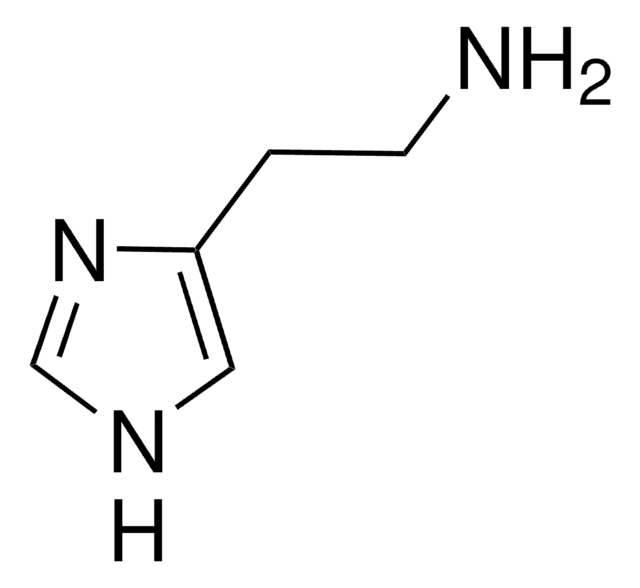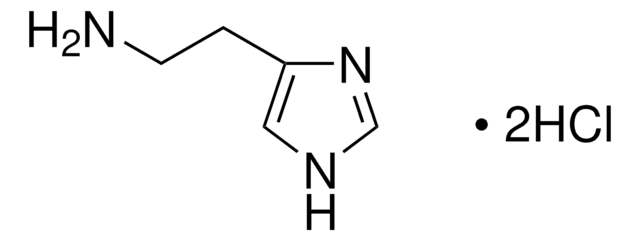D17408
1,7-Diaminoheptane
98%
Synonym(s):
1,7-Heptanediamine, Heptamethylenediamine
Sign Into View Organizational & Contract Pricing
All Photos(1)
About This Item
Linear Formula:
NH2(CH2)7NH2
CAS Number:
Molecular Weight:
130.23
Beilstein:
1734159
EC Number:
MDL number:
UNSPSC Code:
12352100
PubChem Substance ID:
NACRES:
NA.22
Recommended Products
Assay
98%
form
solid
bp
223-225 °C (lit.)
mp
26-29 °C (lit.)
SMILES string
NCCCCCCCN
InChI
1S/C7H18N2/c8-6-4-2-1-3-5-7-9/h1-9H2
InChI key
PWSKHLMYTZNYKO-UHFFFAOYSA-N
Looking for similar products? Visit Product Comparison Guide
General description
1,7-Diaminoheptane, also known as heptamethylenediamine, is an organic compound with two amine groups at opposite ends of a seven-carbon chain. It is widely used in organic synthesis as a building block in the production of polyamides and other polymers.
Application
- Novel Hydrogels for Biomedical Applications: Research on the synthesis and characterization of pH-responsive aminated alginate derivatives using 1,7-Diaminoheptane, targeting advancements in tissue engineering and drug delivery systems. This study showcases the utility of 1,7-Diaminoheptane in developing hydrogels that respond to pH changes, potentially enhancing cell growth and targeted drug release (Khodayar et al., 2023).
- Advanced Materials in Photoluminescence: Investigation into the properties of 1,7-Diaminoheptane in enhancing broadband photoluminescence in hybrid perovskites for optoelectronic applications. This research highlights its potential in developing new materials for efficient light emission technologies (Deng et al., 2020).
Signal Word
Danger
Hazard Statements
Precautionary Statements
Hazard Classifications
Eye Dam. 1 - Skin Corr. 1B
Storage Class Code
8A - Combustible corrosive hazardous materials
WGK
WGK 3
Flash Point(F)
190.4 °F - closed cup
Flash Point(C)
88 °C - closed cup
Personal Protective Equipment
dust mask type N95 (US), Eyeshields, Gloves
Choose from one of the most recent versions:
Already Own This Product?
Find documentation for the products that you have recently purchased in the Document Library.
Customers Also Viewed
Y B Lee et al.
Bioorganic & medicinal chemistry, 6(3), 253-270 (1998-05-06)
Deoxyhypusine synthase catalyzes the first step in the posttranslational biosynthesis of the unusual amino acid hypusine [N epsilon-(4-amino-2-hydroxybutyl)lysine] in eukaryotic translation initiation factor 5A (eIF-5A). eIF-5A and its single hypusine residue are essential for cell proliferation. Two series of 1,7-diaminoheptane
R Zhang et al.
Analytical chemistry, 65(6), 704-706 (1993-03-15)
Tumor cells contain much higher levels of common polyamines such as putrescine, spermidine, and spermine than normal cells. Our previous work demonstrated that high-performance capillary zone electrophoresis with indirect photometric detection was suitable for the determination of underivatized free polyamines
Mervi T Hyvönen et al.
Biomolecules, 10(3) (2020-03-12)
The biogenic polyamines, spermine, spermidine (Spd) and putrescine (Put) are present at micro-millimolar concentrations in eukaryotic and prokaryotic cells (many prokaryotes have no spermine), participating in the regulation of cellular proliferation and differentiation. In mammalian cells Put is formed exclusively
Irena Kralj Cigić et al.
Foods (Basel, Switzerland), 9(5) (2020-05-07)
Sprouts and microgreens are a rich source of various bioactive compounds. Seeds of lentil, fenugreek, alfalfa, and daikon radish seeds were germinated and the contents of the polyamines agmatine (AGM), putrescine (PUT), cadaverine (CAD), spermidine (SPD), and spermine (SPM) in
G Taibi et al.
Journal of chromatography, 614(1), 153-158 (1993-04-21)
A rapid reversed-phase high-performance liquid chromatographic method, using pre-column derivatization with benzoyl chloride and ultraviolet detection at 254 nm, was developed for the simultaneous measurement of polyamines and their monoacetyl derivatives. Calibration curves were linear for concentrations from 1.25 to
Our team of scientists has experience in all areas of research including Life Science, Material Science, Chemical Synthesis, Chromatography, Analytical and many others.
Contact Technical Service










